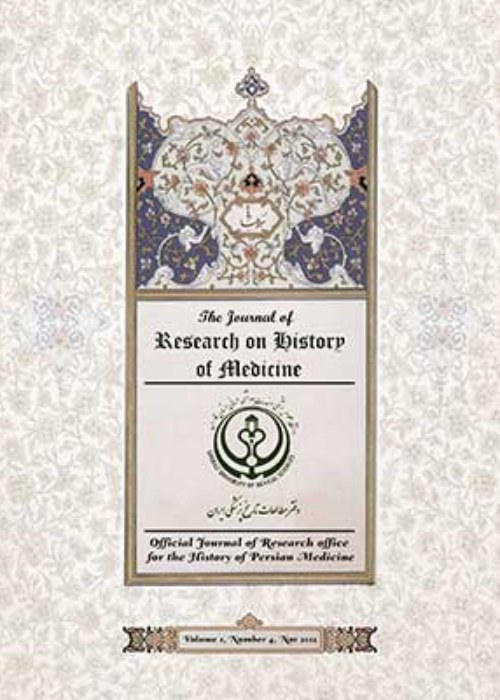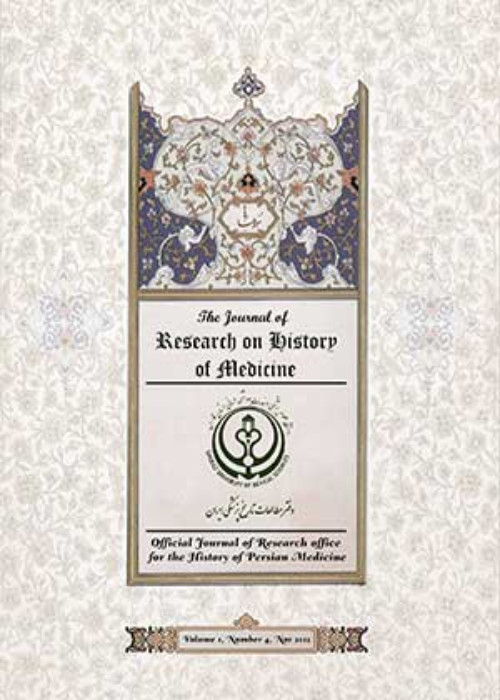فهرست مطالب

Journal of Research on History of Medicine
Volume:11 Issue: 4, Nov 2022
- تاریخ انتشار: 1401/09/15
- تعداد عناوین: 8
-
-
Pages 233-244This study focuses on a correspondence between the surgeon, Fedor Krause (1857 – 1937), and the neurologist, Arthur Simons (1877 – 1942), who specialized in muscle neurology. The correspondence shows many interesting aspects of surgery at the time of World War I. It is especially remarkable that the important surgeon, August Bier (1861 – 1949), is criticized in this correspondence. One major problem of German surgery at the beginning of the 20th century was the fact that patients often were not mobilized sufficiently and instead, unnecessarily were told to stay in bed (“Bettruhe”) for many weeks, and in many cases, patients also were unnecessarily told to move as little as possible. Even giving massages was considered harmful. This is in contrast to today’s principle of early mobility (ERAS). The correspondence between these two scholars clearly indicates that these wrong principles were propagated by certain important surgeons in Germany (like August Bier) and that these principles were rather based on their personal opinions than on scientific evidence. More than 100 years ago, there were already some physicians, like Arthur Simons or Fedor Krause, who openly criticized these wrong approaches in German surgery.Keywords: Mobility, ERAS, Complex regional pain syndromes, 20th century history, World War I
-
Pages 245-256Amīr Khān Amīr-A’lam (1876-1961) can be considered the icon of modern Iranian medicine. Several books and articles have been written about him and various aspects of his professional life have been studied. However, the author of this article, by accessing a collection of newly found documents, has obtained new and interesting information on the modernization of health and medicine and the role of Amīr-A’lam in it. Relying on the accepted methods of historical and documentary research, the author has first introduced and analyzed these documents and then has tried to present, classify and analyze the new information in fields such as the role of Amīr-A’lam in the modernization of military medicine, the establishment of the first women’s hospital, reconstruction of Razavi Dār al-Shafā and finally the establishment and expansion of Iran’s Jamiat-e Shir-o Khorshid (lit. Lion and Sun Society of Iran). These documents show what the state of military medicine was like before modernization, how Amīr-A’lam’s altruistic actions led to the establishment of the Women and Children Hospital, and what obstacles and problems Amīr-A’lam faced in rebuilding the Razavi Dār al-Shafā. Also, for the first time, the establishment and expansion of Iran’s Jamiat-e Shir-o Khorshid, which later became Iran’s Red Crescent Society, is narrated by Amīr-A’lam.Keywords: Amīr Khān Amīr-A’lam, Health, Medicine, Modernization, Iran’s Jamiat-e Shir-o Khorshid, Iran
-
Pages 257-266In the age of development and efflorescence, Islamic medicine was founded on the principle of four temperaments; therefore, the prevalence of various diseases and their treatment methods were carried out based on the view mentioned above, namely, temperament balance loss. According to available resources, it is clear that the recognition and treatment of some dermatoses, such as warts, were affected by this view. Warts are a common dermatosis that is discussed from various aspects and problems based on the four temperaments as perceived by doctors in Islamic civilization. Despite the big misunderstanding in identifying the origin of this disease, mainly due to the lack of required technology and lack of accurate tools, Muslim physicians, unbelievably, were able to accurately examine and explain the type and location of their occurrence. Furthermore, the physicians could adopt appropriate treatment based on their type, extent of infection, and location. It is important to keep in mind that, with some advancements in technology and medicines, most of the treatments and medications that were widely used until the end of the 20th century can be modified to work in modern medicine.Keywords: Treatment, Superstitions, Warts, Herbs, Surgery, Skin diseases
-
Pages 267-278University reform was carried out in Turkiye in 1933. Many people of Jewish heritage, opposition doctors, and others who had fled Nazi persecution in Europe sought safety in Turkiye between 1933 and the end of World War II. Having examined the relevant official state archive documents, we, as our main objective, aimed to share the information obtained about immigrant physicians and scientists who worked at Istanbul University, contributing to establishing the Faculty of Medicine from 1933 until the end of World War II.The study was designed as a qualitative-multiple document analysis. Documents found by scanning the catalog of the Turkish Presidency State Archives Republic Archive Catalog were examined. In addition, other publications on the subject have been read. Seventeen original archival documents on physicians and other scientists who fled Nazi Germany and took refuge in Turkiye are examined. The names of 16 physicians and scientists are mentioned in the documents. They worked at the institute, clinic, School of Dentistry, and School of Pharmacists incorporated in the Faculty of Medicine. In addition to the advantages Turkiye provided for the scientists who took refuge, the country made it simple for their relatives to move and live there. Some of these scientists even acquired Turkish citizenship.It is found that immigrant physicians and scientists who took refuge in Turkiye have made a significant contribution to the development of Turkish medical education and medicine.Keywords: Turkiye, Universities, Medical education, Istanbul, immigrants, History of medicine
-
Pages 279-290In research on the history of modernization in Iran, less attention has been paid to National Health and modernization programs. The main question is why National Health has had a key role in Iran’s modernization programs. The central perspective of the Iranian elites from the Qajar era was that the path toward a healthy, modern, and peaceful society and pass of pandemics would begin with improvements in hygienic conditions. From their point of view, raising a healthy generation would lead to a change in people’s opinions. Findings indicate that health programs were at the top of reformations and modernization in Iran, which considered health and peace the prerequisite of a strong society. Research in all of the manifestos of modernization from the “Counte’s Law to the White Revolution” shows that national hygiene played a key role. Based on this necessity, considering public health and social insurance as essential principles was adopted in the Constitution of the Islamic Republic of Iran. This article is qualitative in terms of explanatory methods and based on library resources and documents.Keywords: Public Health, Modernization programs, Iran, Humans
-
Pages 291-294The WHO Archives in Geneva has been closed to researchers and the public since March 11, 2020. The Archives hold valuable, vast official correspondences, documents, photographs, and other kinds of dated records of the World Health Organization and related defunct establishments dating back to 1907. The closure of the archives became necessary in the wake of the Coronavirus pandemic and the general lockdown that attended it. While normalcy has since returned in virtually every institution and sector across the globe, the closure of the WHO Archives has continued unbroken for over 2 years and 4 months with grave implications for research and scholarship on the history of international public health. This essay is a critique of that protracted closure which is now clearly unnecessary and unjustifiable. It is also a call for an urgent end to it in the interest of the fundamental right of access to information, and knowledge production.Keywords: World Health Organization, Archives, History of medicine, COVID-19


